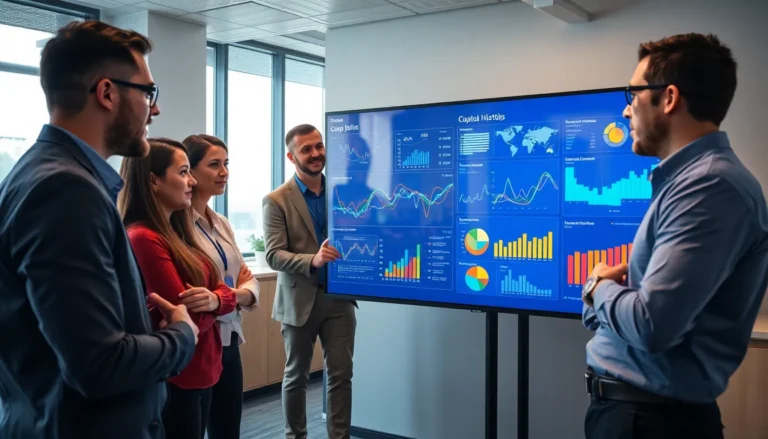In a world where change is the only constant, global foresight emerges as the crystal ball everyone wishes they had. It’s not just about predicting the future; it’s about preparing for it like a pro. Imagine navigating through the unpredictable waters of global trends, technological advancements, and socio-economic shifts with the confidence of a seasoned captain steering a ship through a storm.
Global foresight equips individuals and organizations with the tools to anticipate challenges and seize opportunities before they even knock on the door. It’s like having a GPS for the future, minus the annoying voice telling you to “recalculate.” In this rapidly evolving landscape, understanding global foresight isn’t just an option; it’s a necessity for those who want to stay ahead of the curve and thrive in an ever-changing environment. Get ready to dive into the fascinating world of foresight and discover how to turn uncertainty into your greatest ally.
Table of Contents
ToggleUnderstanding Global Foresight
Global foresight involves predicting and preparing for future trends and challenges. This concept equips individuals and organizations with the tools necessary to navigate uncertainties effectively.
Definition and Concept
Global foresight refers to the systematic process of exploring emerging trends and potential future developments. It encompasses the use of data analysis, scenario planning, and expert insights to identify patterns in global dynamics. By integrating various perspectives, global foresight fosters a holistic understanding of complex issues. It allows stakeholders to recognize the interplay between technological advancements, socio-economic changes, and environmental factors shaping the future.
Importance in Today’s World
The significance of global foresight in today’s rapidly evolving landscape cannot be overstated. Organizations utilize this approach to anticipate disruptions and innovate effectively. Proactively preparing for change means developing strategies that align with future realities. Individuals gain insights that inform personal and professional decisions. In a world characterized by volatility, foresight enables resilience and adaptability. This capability supports informed decision-making, allowing both businesses and individuals to seize opportunities that may arise from shifting trends.
Tools and Techniques

Global foresight employs various tools and techniques to enhance predictive capabilities and strategic planning. Utilizing these methods aids organizations in navigating future uncertainties effectively.
Scenario Planning
Scenario planning involves creating detailed narratives about potential future events. By exploring different possibilities, organizations can develop insights into how various factors might converge. This technique encourages teams to envision both best-case and worst-case scenarios, enabling them to prepare for a range of outcomes. For instance, businesses might analyze shifts in consumer behavior, technological advancements, and regulatory changes to craft robust strategies. Incorporating diverse perspectives ensures a comprehensive view of potential challenges, allowing organizations to make informed decisions.
Trend Analysis
Trend analysis focuses on identifying and evaluating significant patterns in data over time. This technique helps organizations understand evolving market dynamics and consumer preferences. Data collected from various sources, such as social media trends, economic indicators, and demographic shifts, offers valuable insights. Through this analysis, stakeholders can pinpoint emerging trends that could impact their industries. Adapting to these trends supports proactive decision-making and encourages innovation. Regular monitoring of trends ensures that organizations remain agile and responsive to changes in the global landscape.
Applications of Global Foresight
Global foresight finds significant applications across various sectors, enhancing decision-making and strategic planning. This approach provides valuable insights for navigating complexities.
Economic Forecasting
Economic forecasting leverages global foresight to predict market trends and economic shifts. Organizations utilize statistical models for analyzing data, directly informing investment strategies. For instance, businesses can forecast consumer behavior changes, allowing them to align products with emerging demands. Economists evaluate global indicators such as GDP growth and inflation rates, deriving insights that influence fiscal policy. Accurate forecasting promotes informed decision-making, helping nations and corporations maintain competitiveness amidst rapid changes. Stakeholders who adopt these practices often experience improved sustainability in economic planning.
Environmental Sustainability
Environmental sustainability benefits immensely from global foresight applications. Through proactive analysis, organizations can identify potential environmental threats and opportunities for innovation. They assess climate data, guiding projects aimed at reducing carbon footprints and enhancing resource efficiency. Green technologies often emerge from foresight initiatives, as stakeholders seek ways to meet regulatory requirements while fostering ecological balance. Public agencies utilize scenario planning to envision diverse environmental futures, influencing long-term policy formation. Adopting these strategies ensures that sustainability efforts align with future ecological needs and societal priorities.
Challenges in Global Foresight
Global foresight encounters significant challenges, making accurate predictions and strategic planning difficult. These challenges stem from various factors, including uncertainty and data limitations.
Uncertainty and Complexity
Complexity often arises from the interconnectedness of global systems. Events in one region can influence outcomes elsewhere. Anticipating these ripple effects presents a challenge, as unforeseen variables can alter trajectories. Decisions may rely on assumptions that quickly become outdated. Uncertainty complicates scenario planning, making it tough for organizations to outline precise paths. Stakeholders must remain adaptable to respond effectively to rapid changes.
Data Limitations
Data availability and quality impact the effectiveness of global foresight. Organizations face hurdles in sourcing reliable information from diverse regions. Inaccurate or outdated data can lead to misguided strategies. Furthermore, data silos prevent comprehensive analysis, limiting insights into trends and patterns. Stakeholders must invest in robust data-gathering methods to enhance predictive accuracy. Effective collaboration with various sectors can improve data sharing, facilitating better foresight initiatives.
Future of Global Foresight
Global foresight adapts continuously to changes in society and technology, establishing itself as a necessary tool for navigating future challenges. Innovations and trends shape the landscape, making it vital for organizations to remain aware.
Innovations and Trends
Organizations must prioritize new methodologies that enhance global foresight capabilities. Artificial intelligence facilitates advanced data analysis, leading to more accurate predictions. Scenario simulations enable teams to visualize future outcomes, prompting strategic discussions. Moreover, crowdsourcing ideas from diverse contributors fosters creativity and broadens perspectives. Industry collaboration brings in varied expertise, enriching the foresight process. Staying informed about emerging trends allows organizations to spot opportunities quicker, ensuring they remain competitive.
The Role of Technology
Technology acts as a backbone for effective global foresight. Data analytics tools provide insights into current behaviors and preferences, enabling better forecasting. Geographic information systems analyze spatial data, assisting in understanding complex global interconnections. Automation streamlines information gathering, reducing the time spent on manual processes. Furthermore, virtual collaboration platforms encourage team engagement, regardless of location. Blockchain technology enhances data security and transparency, ensuring stakeholders can trust the resources they rely on. Overall, technology empowers organizations to implement proactive strategies and remain resilient in a shifting global landscape.
Global foresight is an indispensable asset for navigating the complexities of today’s world. By leveraging tools like scenario planning and trend analysis, individuals and organizations can better prepare for the uncertainties ahead. Embracing this proactive approach not only enhances decision-making but also fosters resilience in the face of rapid change.
As technology continues to evolve, the ability to anticipate future trends becomes even more critical. Organizations that prioritize global foresight will find themselves better equipped to seize opportunities and mitigate risks. Ultimately, staying ahead requires a commitment to understanding the interconnected nature of global systems and a willingness to adapt strategies accordingly.









